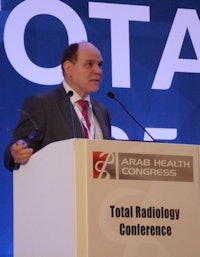
DUBAI - In a society where modernity often comes up against tradition, the challenge is to find a way to educate both sides of the community, according to the director of the Saudi Arabia national breast screening program, who spoke on the topic at the Total Radiology Conference at Arab Health 2016.
According to official figures, breast cancer is the most common cancer in women in Saudi Arabia, at 28%, with most women diagnosed between the ages of 47 and 49 (50% to 79% are premenopausal) and 26.4% diagnosed in their 30s (compared with 6.5% in the U.S.).
 Dr. Fatina Al Tahan.
Dr. Fatina Al Tahan.With one of the highest birth rates in the region, breast cancer rates in Saudi Arabia are projected to increase if women continue to present at such an early age and at such a late disease stage. Coupled with the lack of general awareness and education about early screening, a social stigma, worry about financial implications of diagnosis, and the adoption of increasingly sedentary lifestyles, the problem will only be compounded unless public health practices are changed, according to Dr. Fatina Al Tahan, director of the National Breast Cancer Screening Program at the Saudi Ministry of Health.
"There is an effective and affordable way to educate our female population and healthcare providers about the importance of early diagnosis, and we needed to get the message across to our policymakers that this should be considered as an investment, rather than a cost," Al Tahan told the audience.
A nationwide model
The objective of the National Breast Cancer Screening Program, which launched in March 2012, was not only to reduce mortality rates and the economic burden of the disease, but also to ensure that every woman diagnosed with breast cancer in Saudi Arabia becomes a survivor and can go on to have a good quality of life.
Phase 1 of the screening program began in the kingdom's capital, Riyadh, and was evaluated and assessed as a nationwide model of screening. Initial results from the program (2012-2015) indicate a 90% survival rate; out of 33,000 screenings, 198 women were diagnosed and treated (60% at an early stage).
Al Tahan believes that the long-term success of any national screening program depends on a number of factors including political commitment, sound organization and comprehensive planning, and clear direction and commitment from the leader of the program.
"There should be a functional infrastructure and sustainable resources, as well as a complete pathway of the diagnosis and treatment," she explained. "We need to set the policy guidelines and have a stringent set of performance indicators to enable us to achieve international standards."
Lessons to be learned
To achieve these goals and set a benchmark for the wider region, Al Tahan outlined a number of key points from the current screening program in Saudi Arabia:
- Quality is critical to the success of any screening program, and performance indicators should be monitored closely.
- A clear strategy must be set for community intervention to increase participation.
- Collaboration with the primary care sector is imperative, with key performance indicators to monitor progress.
- Strategic partnerships must be formed with all existing community screening centers to unify awareness activities.
- A screening program will fail without efficient and stable IT solutions and screening software.
- Research is mandatory and will contribute to better outcomes.
According to Al Tahan, Saudi Arabia is looking to roll out a gradual and quality-controlled expansion plan from 2016 to 2020, with particular emphasis on specialized training for the primary care sector and further investment in infrastructure.
Beyond screening
Delegates at the Total Radiology Conference's Breast Imaging session were also treated to the latest research from the region on image-guided breast biopsies.
 Dr. Mohamed Abdel Nabi.
Dr. Mohamed Abdel Nabi.Dr. Mohamed Abdel Nabi, head of radiology at the United Arab Emirates' Ministry of Health, outlined the clinical indications of performing a breast biopsy and discussed technique changes and solutions for performing biopsies with image guidance.
"Our goal is to detect and diagnose cancer before it grows or metastasizes," Abdel Nabi said. "In the U.S., out of 44 million mammograms, 1.7 million biopsies are performed. Out of every 1,000 patients screened, 100 patients will be recalled, 20 will be biopsied, and four cancers will be detected."
Regardless of the image-guidance method, the process needs to be safe and swift without compromising the tissue sample, he said.



















